Railweb Reports
A quantum step for freight in the Basel area
Posted by George Raymond on September 5, 2016
A group of leading Swiss logistic companies hopes to engineer a quantum step in multimodal connectivity for freight by completing a new tri-modal terminal in Basel by 2022. The terminal was one focus of an April 26-27, 2016, conference on railway issues in the Basel area, which covers corners of Switzerland, France and Germany.
Contents
| The situation in Basel | |
| The proposed new terminal | |
| The surrounding world |
Growing traffic and scarce capacity
Rail capacity around Basel is and will remain scarce. Freight trains compete for capacity with passenger trains, including both intercity trains and those of Basel’s tri-national S-Bahn metropolitan-area network. The number of S-Bahn trains will grow with the proposed building of rail lines to the Basel-area airport by 2023 and a set of cross-city tunnels by 2030. Basel is on two European rail freight corridors:
- the Rhine-Alpine Corridor 1 from the North Sea ports via Duisburg to Genoa, and
- the North Sea – Mediterranean Corridor 2 from the North Sea ports and northern French ports to Lyon and Basel.
Ralf Chaumet, development head for Basel’s S-Bahn, said the city has the heaviest rail freight traffic in the entire trans-European transport network (TEN-T).
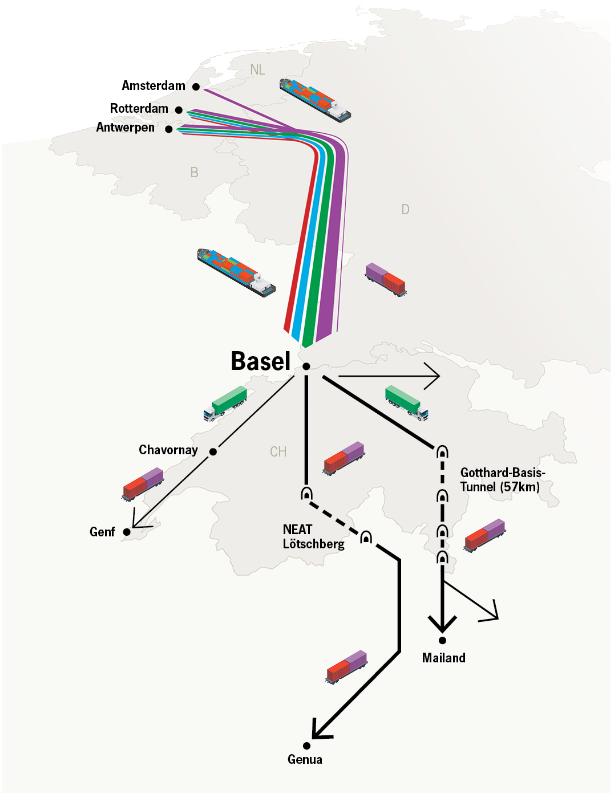 The port and intermodal terminals of Basel lie on the freight corridor between the North Sea ports and Italy. The corridor is Europe’s busiest. Hans-Peter Hadorn presentation.
The port and intermodal terminals of Basel lie on the freight corridor between the North Sea ports and Italy. The corridor is Europe’s busiest. Hans-Peter Hadorn presentation.
Basel’s Port of Switzerland today
Hans-Peter Hadorn is director of the Port of Switzerland, which groups Swiss port facilities on the Rhine river in the Basel area. He said the facilities form a strategic import-export hub for Switzerland. The notions of import and export – and customs duties – remain relevant in Switzerland, which is not part of the European Union.
More than 25% of the maritime containers that enter Switzerland do so via Port of Switzerland terminals, Hadorn said, which also receive 12% of all import tonnes and 35% of mineral oil imports. The destination of 70% of the import tonnage lies outside northwestern Switzerland. The new Swiss railway base tunnels on the Lötschberg and Gotthard routes will further stimulate traffic on the entire Rotterdam-Genoa corridor.
Hadorn said that high water stops Rhine ships only two to three days a year. Every five to six years, low water forces reduction of loads, but doesn’t stop ships. The Rhine has no restrictions on which countries’ ships can serve which ports. He said it has no traffic jams and has no night, holiday or weekend closures.
Florian Röthlingshöfer, deputy chief for the Port of Switzerland’s facilities and railway, said the 1868 Mannheim Act laid down the principal of the Rhine as a neutral, international waterway. Basel’s Port Basin 1 opened in 1922, the ports of Birsfelden and Muttenz in 1937-40, Port Basin 2 in 1941-46 and the Westquai container terminal in 1981. The Port of Switzerland currently handles 6 to 7 million tons of goods annually, including about 120,000 container TEUs.
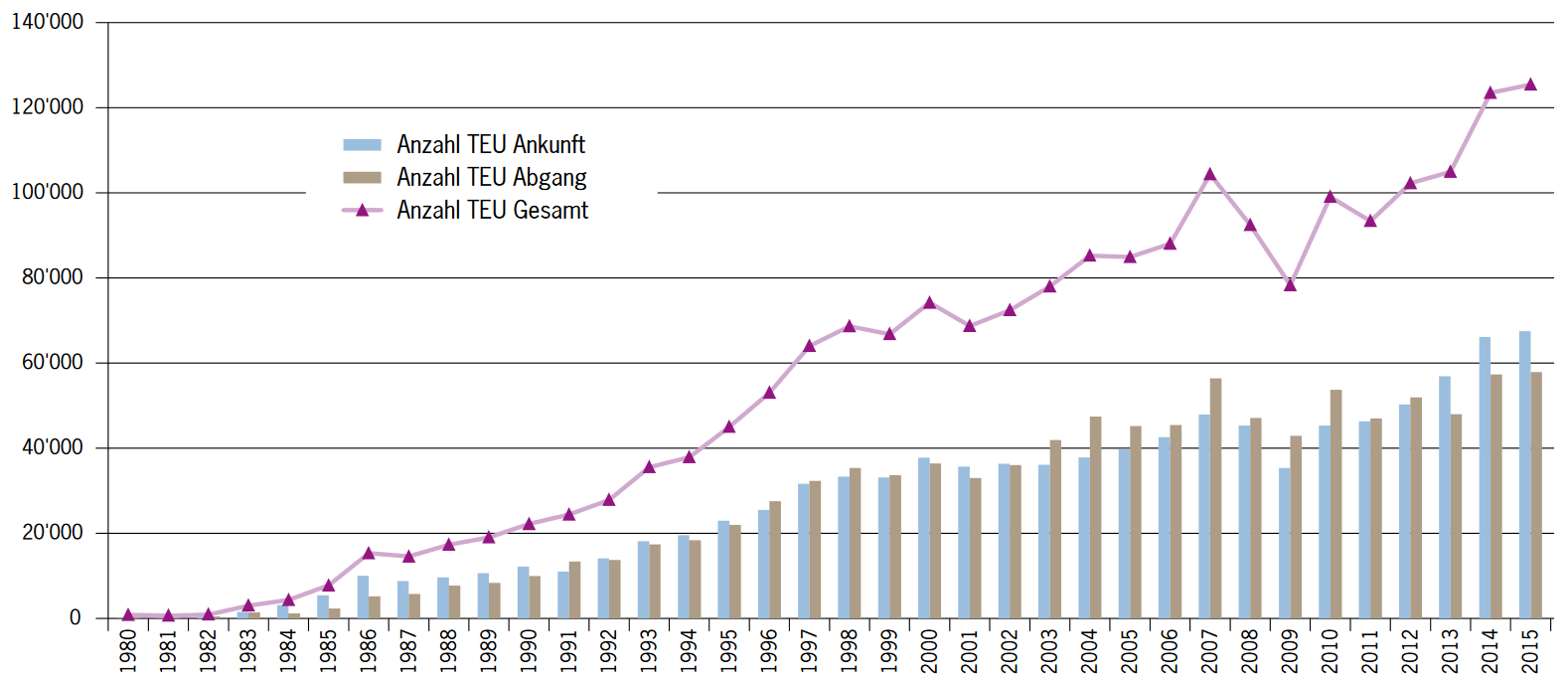 Growth of container traffic at the port facilities of Basel collectively known as the Port of Switzerland. Hans-Peter Hadorn presentation.
Growth of container traffic at the port facilities of Basel collectively known as the Port of Switzerland. Hans-Peter Hadorn presentation.
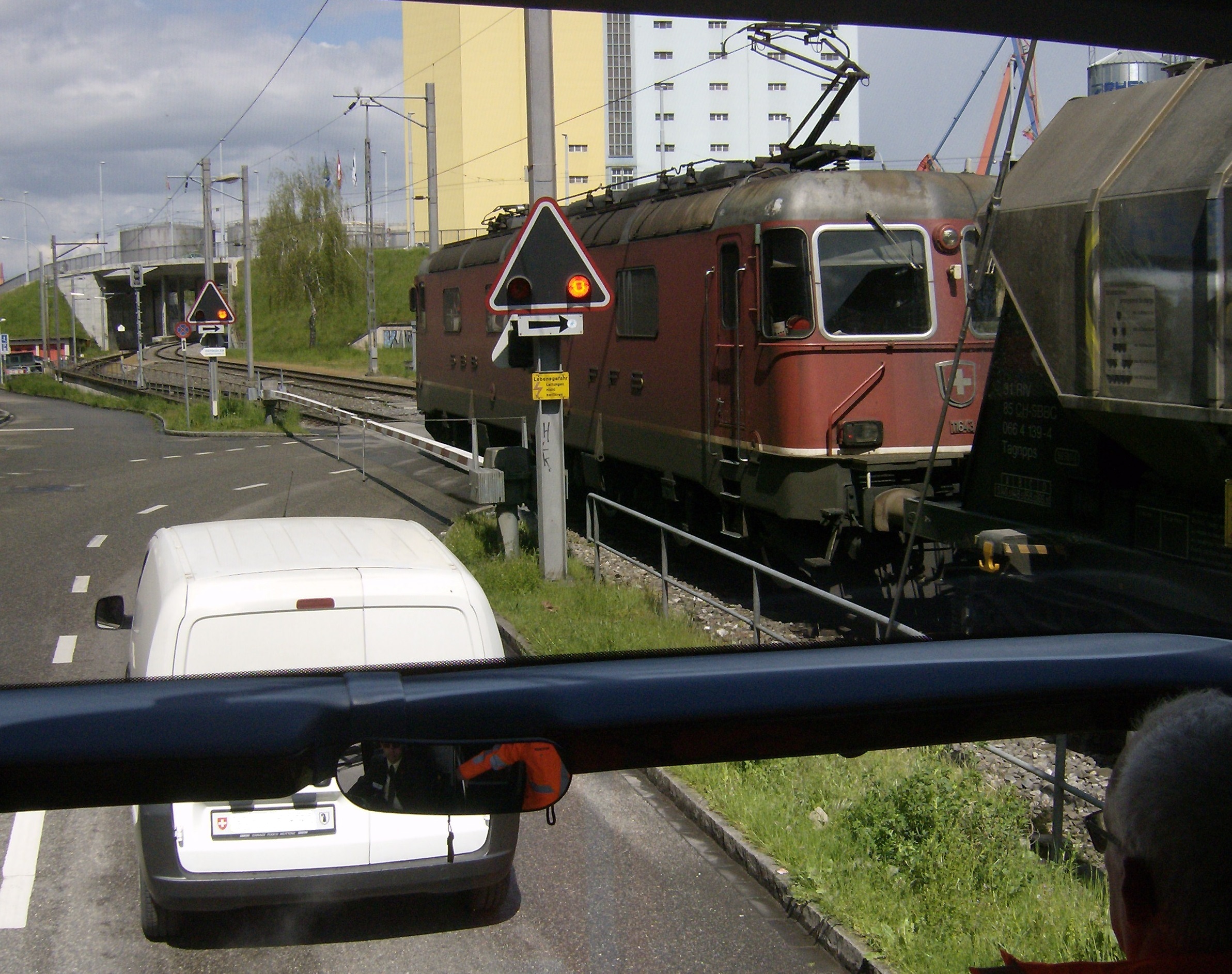 Some 60% of goods arriving by water at the port of Basel continue their journey by train. An outbound freight moves through Basel’s port trackage on April 27, 2016. George Raymond photo.
Some 60% of goods arriving by water at the port of Basel continue their journey by train. An outbound freight moves through Basel’s port trackage on April 27, 2016. George Raymond photo.
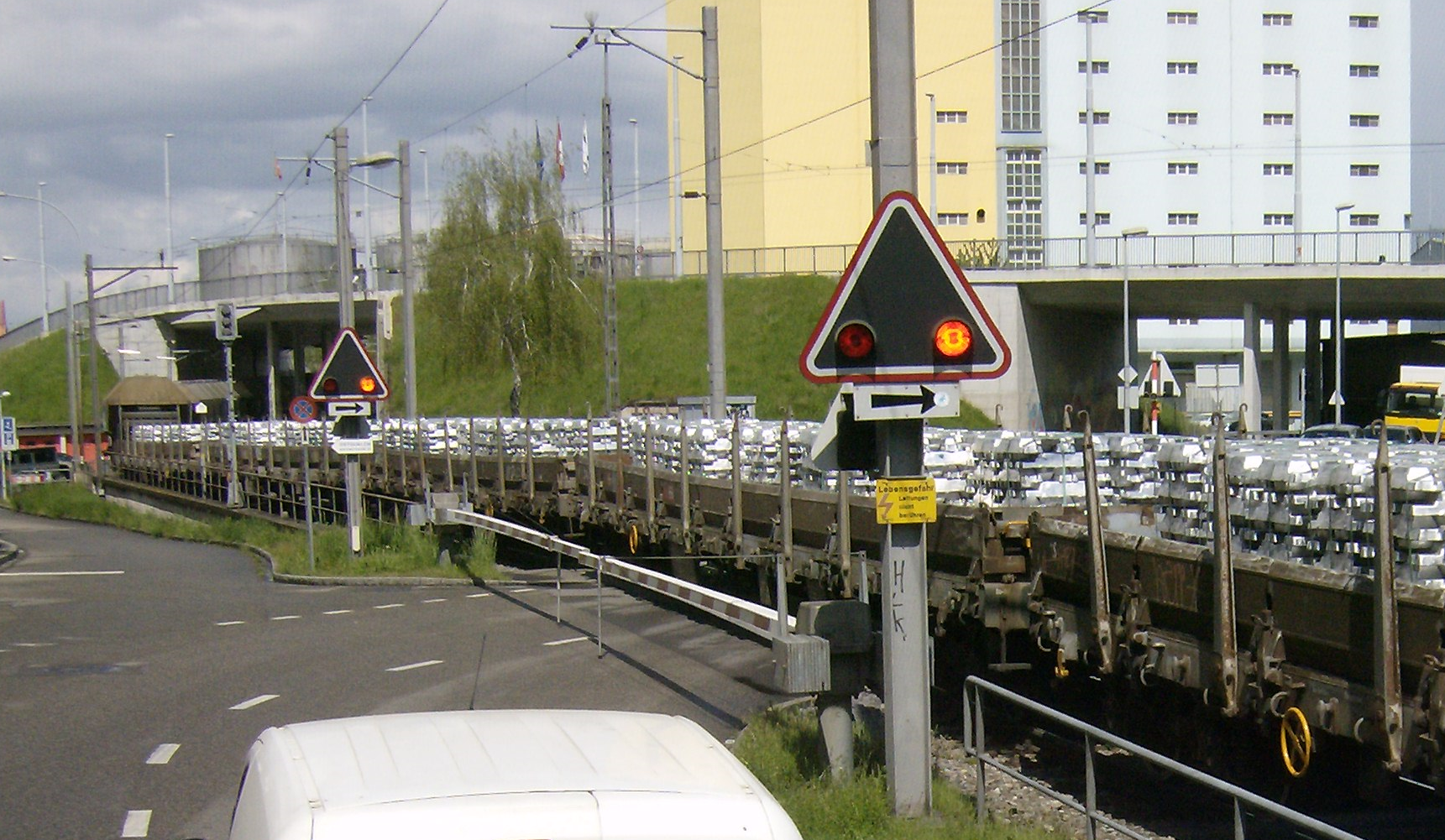 The same train carries ingots out of the port of Basel on April 27, 2016. George Raymond photo.
The same train carries ingots out of the port of Basel on April 27, 2016. George Raymond photo.
Like its home city, the Port of Switzerland’s perspective is tri-national. Hadorn said that a joint venture of the southern Upper Rhine ports of Ottmarsheim in France, Weil am Rhein in Germany and the Port of Switzerland (including its facilities in Kleinhüningen, Birsfelden and Muttenz) are developing a RheinPorts Information System (RPIS).
Gateway Basel Nord: the proposal
in June 2015, Swiss Federal Railways’ freight unit SBB Cargo, the logistic company Contargo and the intermodal operator Hupac formed Gateway Basel Nord (GBN) to develop a new tri-modal intermodal terminal in Basel. Senior officials of SBB Cargo and the Port of Switzerland presented the project at the Basel conference on April 27.
GBN will be a Swiss national container terminal for rail, road and the Rhine. In other words, it will not be a terminal for goods from or to neighbouring areas of France and Germany, which unlike Switzerland lie within the European Union. Instead, GBN will only be for Swiss imports and exports.
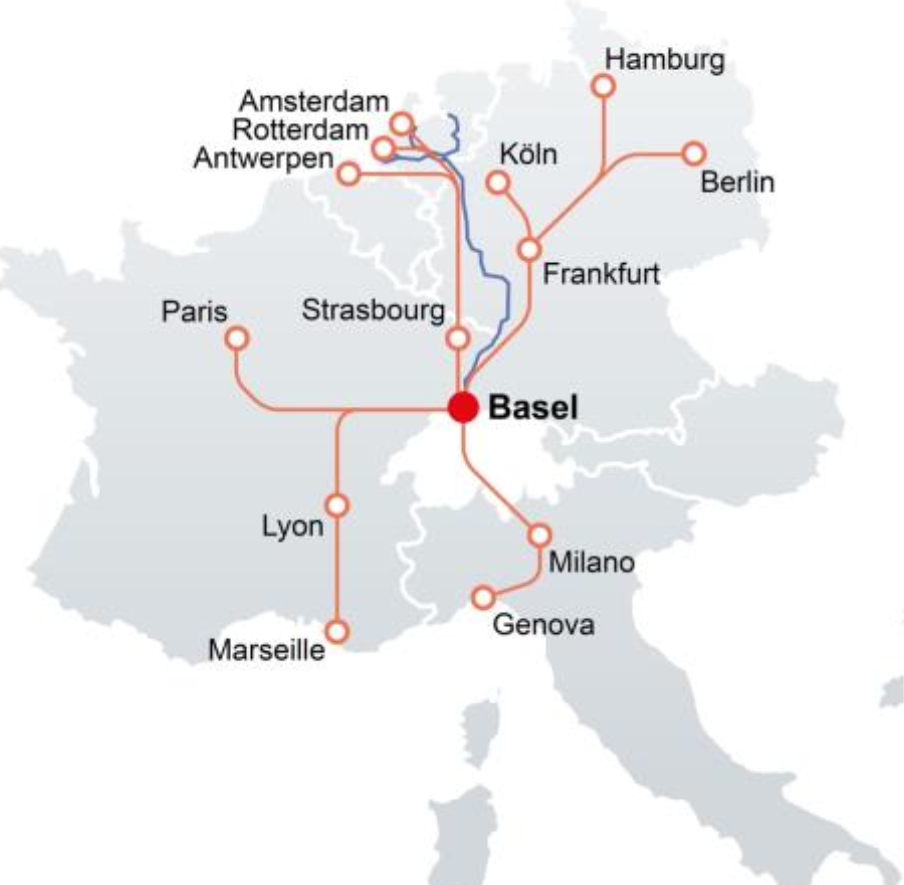 Links from Gateway Basel Nord (GBN): via Strasbourg to Antwerp and Rotterdam; via Frankfurt to Cologne, Hamburg and Berlin; to Genoa and Milan; but also to Paris, Lyon and Marseille. Presentation of Nicolas Perrin, CEO of SBB Cargo.
Links from Gateway Basel Nord (GBN): via Strasbourg to Antwerp and Rotterdam; via Frankfurt to Cologne, Hamburg and Berlin; to Genoa and Milan; but also to Paris, Lyon and Marseille. Presentation of Nicolas Perrin, CEO of SBB Cargo.
The proposed GBN will start as a road-rail terminal in 2019-2020, initially taking over container traffic from Basel’s inner-city Wolf terminal. An expanded road-rail terminal will open in 2021 and a tri-modal terminal, including a new Port Basin 3, in 2022. GBN’s capacity will then be 390,000 TEUs a year.
Port of Switzerland’s Hadorn said that German terminals have been taking traffic away from decentralised Swiss terminals. SBB Cargo CEO Nicolas Perrin said that one objective of GBN is to assure business for Swiss logistics companies.
Another GBN objective is to assure Swiss control over modal-choice incentives for container distribution within Switzerland. Although GBN will consolidate some traffic formerly or now handled by smaller Swiss terminals, many of those terminals will retain a role in the distribution by rail of containers arriving in Switzerland via GBN. Swiss Federal Railways’ CEO Andreas Meyer said he wants to increase the rail share of onward transport of containers arriving in Basel’s tri-modal terminals from today’s 20% to 50%. This will require a network of hinterland terminals in Switzerland.
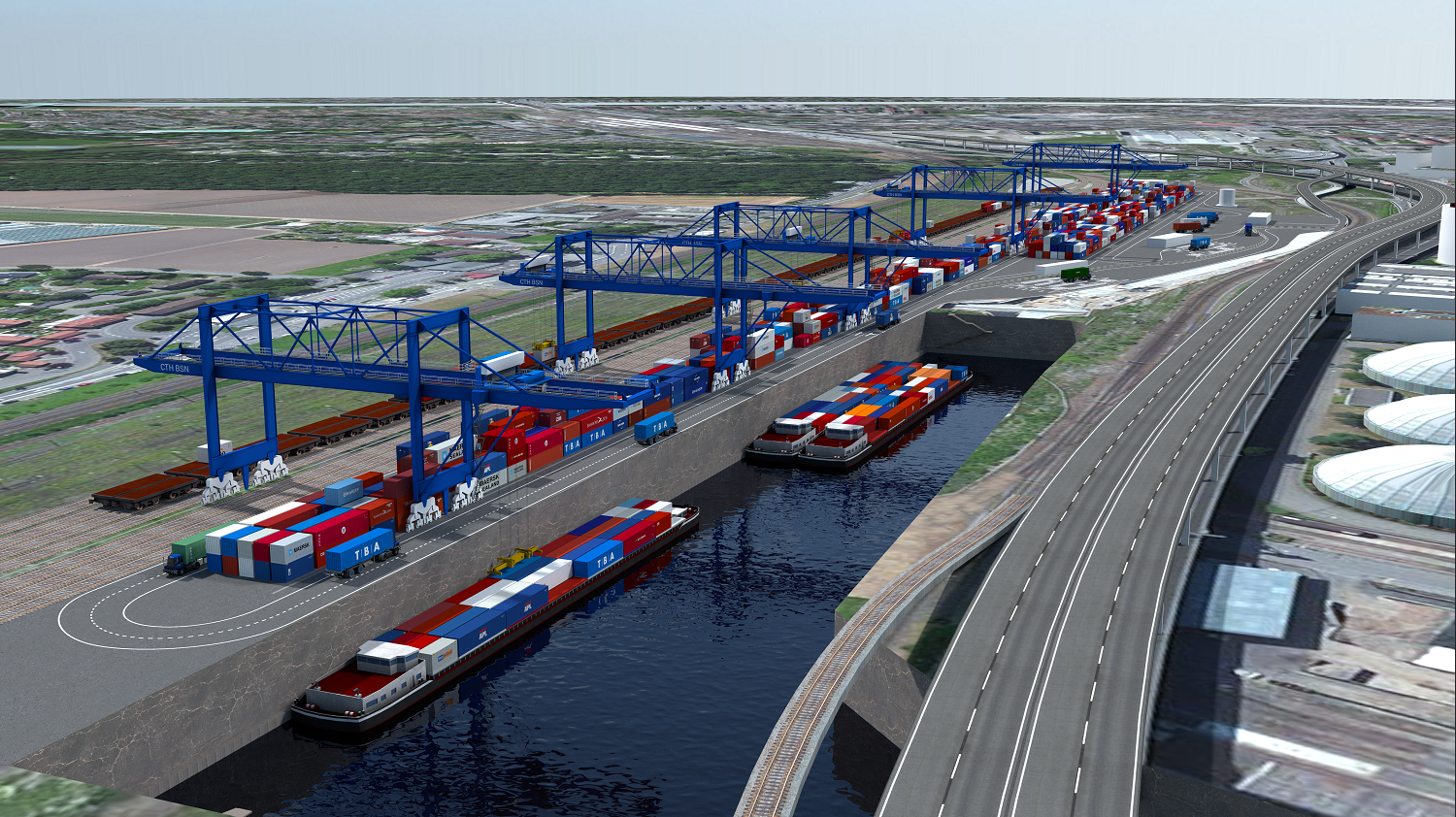 The proposed Gateway Basel Nord (GBN) tri-modal container terminal, looking south toward the city of Basel. On the far left is the existing main rail line from Basel north into Germany; on the right is the existing motorway, under which the access channel to the terminal will be dug. Source: www.gateway-baselnord.com.
The proposed Gateway Basel Nord (GBN) tri-modal container terminal, looking south toward the city of Basel. On the far left is the existing main rail line from Basel north into Germany; on the right is the existing motorway, under which the access channel to the terminal will be dug. Source: www.gateway-baselnord.com.
Port of Switzerland’s Röthlingshöfer said that GBN will offer six 750-metre tracks plus a run-around track for locomotives. The tracks will be long enough for any train able to use Basel’s approach lines.
Given GBN’s status as a neutral transport hub, Röthlingshöfer said, its Port Basin 3 will qualify for up to 50% construction funding from the Swiss federal government and its adjacent road-rail terminal up to 80%. GBN will neutrally allocate slots among train operators. Longer trains won’t automatically have priority. A commission will resolve disputes.
“When we say something is discrimination-free,” said Swiss Federal Railways’ Meyer, “it is much more discrimination-free than in other countries”.
Six 750-metre tracks and a 330-metre dock
A Rhine container ship generally pushes an unpowered barge of similar size. Together they are typically 130 metres long. Röthlingshöfer said that GBN’s six tracks will parallel the terminal’s 330-metre-long Port Basin 3, which will be able to handle four Rhine container ships at once, two along the dock side-by-side with two others. Ships will reach Port Basin 3 via a 1-kilometre, mostly existing canal some 55 metres wide. Simulations have confirmed that ships will be able to manoeuvre efficiently.
Beat Lampart of SBB Cargo said that extending Port Basin 3’s dock past 330 meters wouldn’t help GBN’s capacity much, because the terminal’s initial three gantry cranes will still have to move the length of the terminal to get containers to the right place on ships, trains and trucks. Again here, simulations have demonstrated that the cranes can operate efficiently.
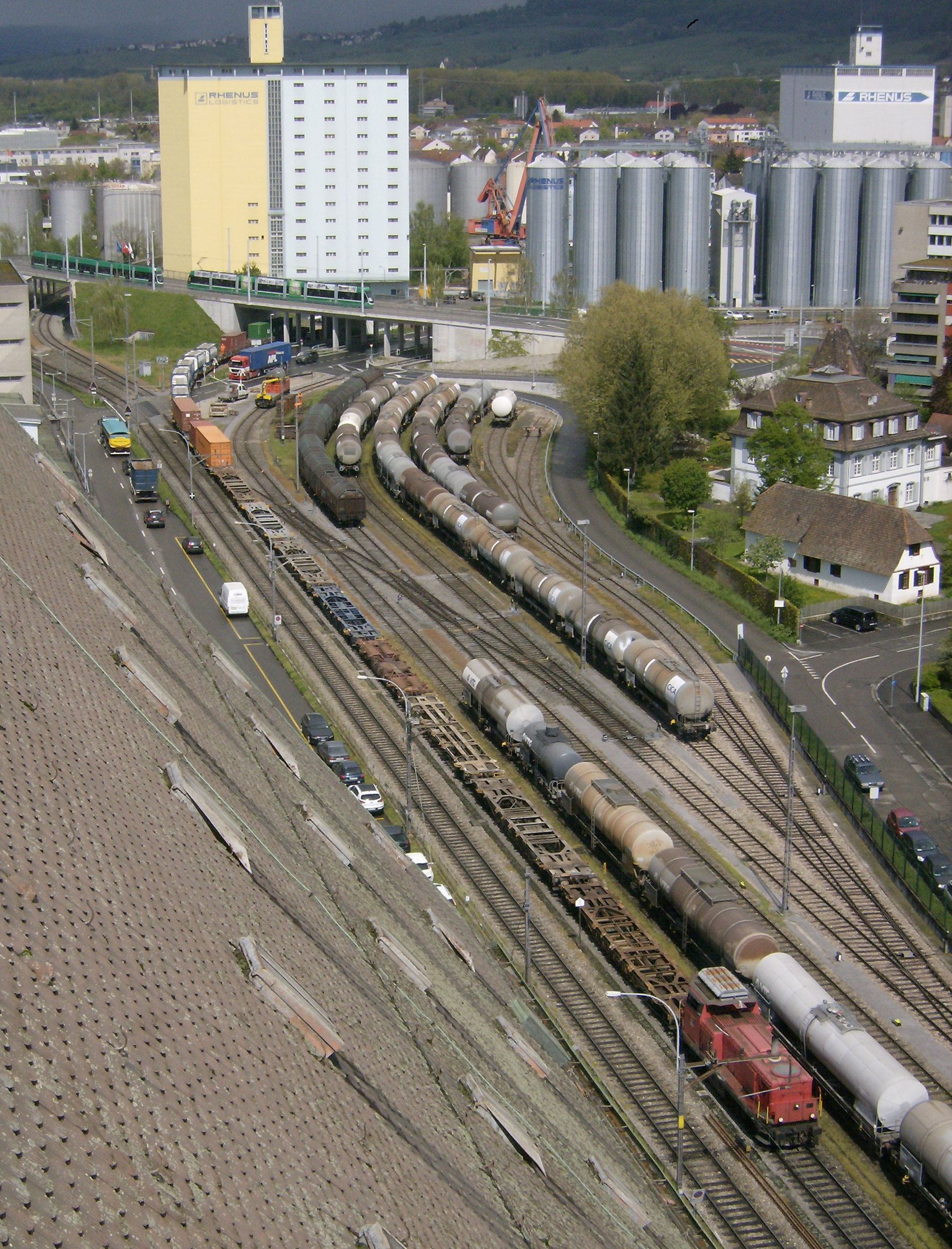 The GBN tri-modal terminal will let the Port of Switzerland offer faster transfer of more containers between ships and trains. Above, two green trams of Basel’s cross-border tram line 8 into Weil am Rhein (Germany) pass over a partly-loaded container train being shunted in Basel’s Kleinhüningen port facilities. George Raymond photo, April 27, 2016.
The GBN tri-modal terminal will let the Port of Switzerland offer faster transfer of more containers between ships and trains. Above, two green trams of Basel’s cross-border tram line 8 into Weil am Rhein (Germany) pass over a partly-loaded container train being shunted in Basel’s Kleinhüningen port facilities. George Raymond photo, April 27, 2016.
Lampart said that the GBN terminal will have rail links to the German national rail network and the Basel port network, but not to Swiss Federal Railways. Until about 2020, the GBN road-rail terminal will operate with hand-thrown track turnouts that an electronic control system will replace before the opening of Port Basin 3.
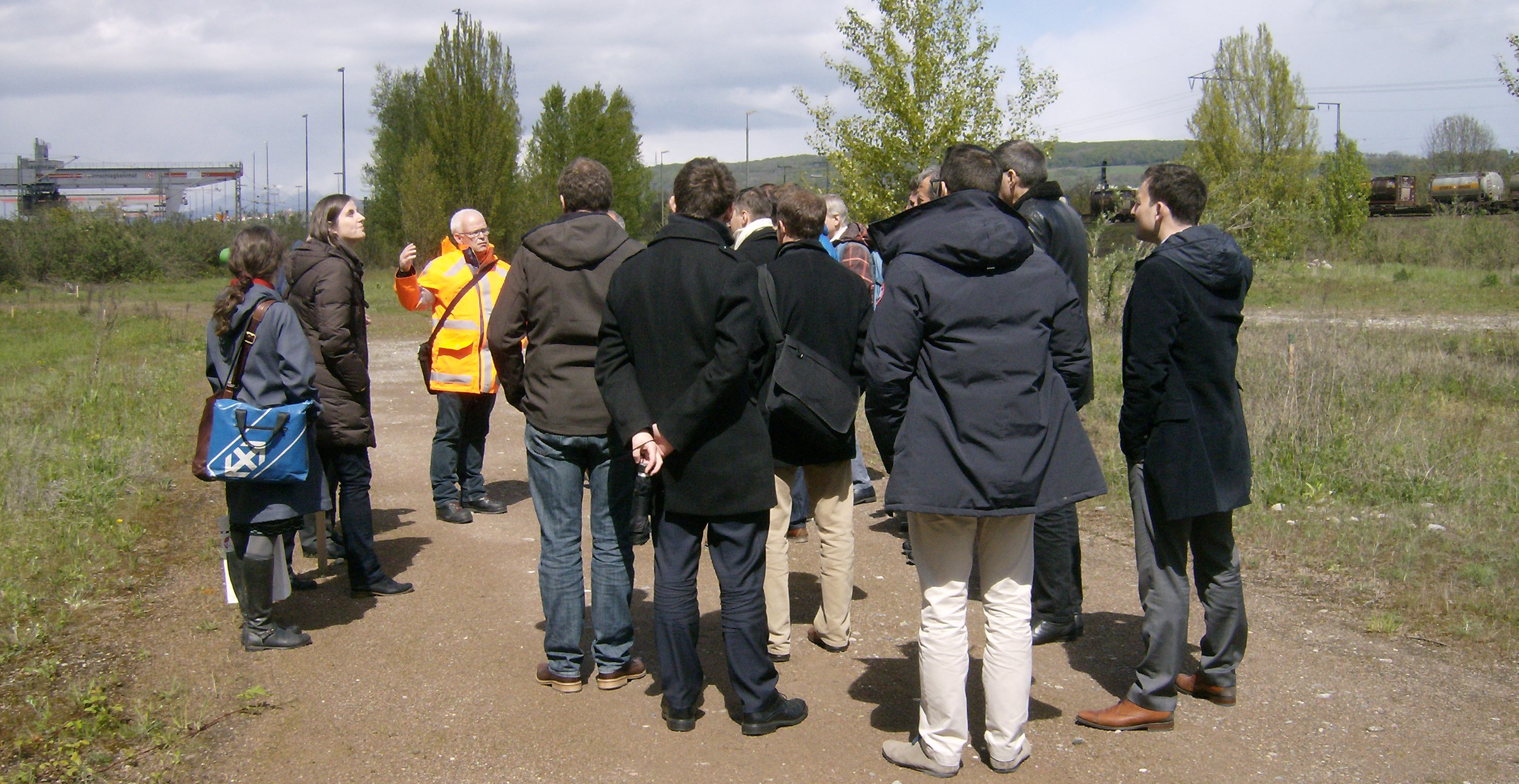 Beat Lampart of SBB Cargo presents the still-empty site of Gateway Basel Nord (GBN) to bk16 conference participants on April 27, 2016. We are looking north. In the left background is the DUSS intermodal terminal, just over the border in Germany, and on the right is the main railway line into Germany. George Raymond photo.
Beat Lampart of SBB Cargo presents the still-empty site of Gateway Basel Nord (GBN) to bk16 conference participants on April 27, 2016. We are looking north. In the left background is the DUSS intermodal terminal, just over the border in Germany, and on the right is the main railway line into Germany. George Raymond photo.
Just north of the GBN site, which lies in Switzerland, is a DUSS container terminal that lies on German soil. Lampart said that today, the DUSS terminal handles significant Swiss traffic. GBN wants to cooperate with the DUSS terminal, Lampart said, not compete. A track will probably link them. The main objective of all terminals, he said, is to help make intermodal transport cheaper and more attractive to shippers than road transport.
Calls for other rail development work in the Basel region
Representatives of French, German and Swiss chambers of commerce within the Basel metropolitan area promoted other rail infrastructure projects in the tri-national region. All could benefit both passengers and freight services. They include:
- Upgrading the line between Mulhouse (France) and Müllheim (Germany)
- Re-opening the line between Colmar (France) and Freiburg im Breisgau (Germany), whose Rhine bridge was bombed in World War II
- Building the last gaps in the Rhine-Rhone high-speed rail line to gain 8 minutes for passengers and free capacity on the parallel legacy rail lines for freight
- Building a third tunnel through Switzerland’s Jura mountains
Patrick Hell of the chamber of commerce and industry of southern Alsace and Mulhouse spoke in favour of Rhine-Rhône rail freight services between Barcelona and Basel.
Conference speakers hardly mentioned the Cargo Sous Terrain (CST) proposal to build privately funded tunnels for the automatic, autonomous movement of freight containers among the main industrial and distribution zones of central Switzerland. Sven Hantel of Deutsche Bahn’s Baden Württemburg region said that CST’s great advantage would be its silence, but Swiss Federal Railways’ CEO Andreas Meyer called CST a pipe dream.
Interregional Alliance for the Rhine-Alpine Corridor
Basel and its proposed GBN terminal lie on Europe’s busiest north-south freight corridor. Jörg Saalbach, director of the Rhine-Alpine Corridor Rotterdam-Genoa, presented the Interregional Alliance for the Rhine-Alpine Corridor. Of the nine freight corridors defined by the EU, it is the shortest at 1300 km, but carries the most traffic and 50% of north-south freight.
On the basis of a bottom-up approach from cities and regions, Saalbach said, the Alliance seeks to bundle interests; make the corridor more visible; perform comprehensive planning including all stakeholders and aspects (including transport, land use and economic development); establish investment priorities; achieve more speed and multimodality and more and better capacity use.
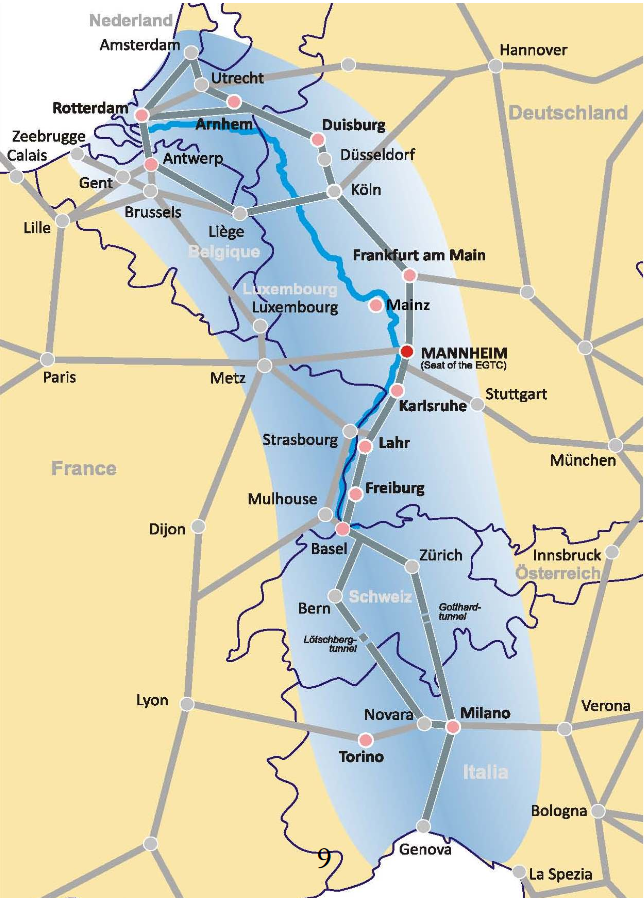 The cities and ports of the Rhine-Alpine Corridor Rotterdam-Genoa. Jörg Saalbach presentation.
The cities and ports of the Rhine-Alpine Corridor Rotterdam-Genoa. Jörg Saalbach presentation.
The Alliance’s members, Saalbach said, include representatives of the transport sector, national policy makers, government at regional and local levels, and users, including shippers, passengers and their associations. The Alliance is continuing to develop corridor strategy, generate EU-funded projects, lobby for regional-communal interests, serve as platform for interactions and intervene as a member of the EU Corridor Forum in Brussels.
Trends and technology
Nils Planzer, CEO and chairman of the board of Planzer Transport AG, said that rail and trucking are working better together today than in the past. Planzer, he said, is simply a transport company. He cautioned that shippers do not make decisions for environmental reasons.
Nicolas Perrin of SBB Cargo predicted that the intelligence of cars will spread to include railways. The quest for safety in robot cars will lead to as much regulation as for trains and planes, however. Just as important as Basel’s proposed cross-city tunnel for passenger trains or the Gateway Basel Nord terminal project for freight is the data and intelligence in the “cloud overhead”.
Swiss Federal Railways’ CEO Andreas Meyer said that his company wants to join the movement towards robot cars to attain “self-driving public transport.“ But he noted the lagging development of intelligent rail freight wagons.
George Raymond can be reached at graymond@railweb.ch.
© Copyright 2016 George Raymond. All rights reserved.
Back to Railweb Reports
